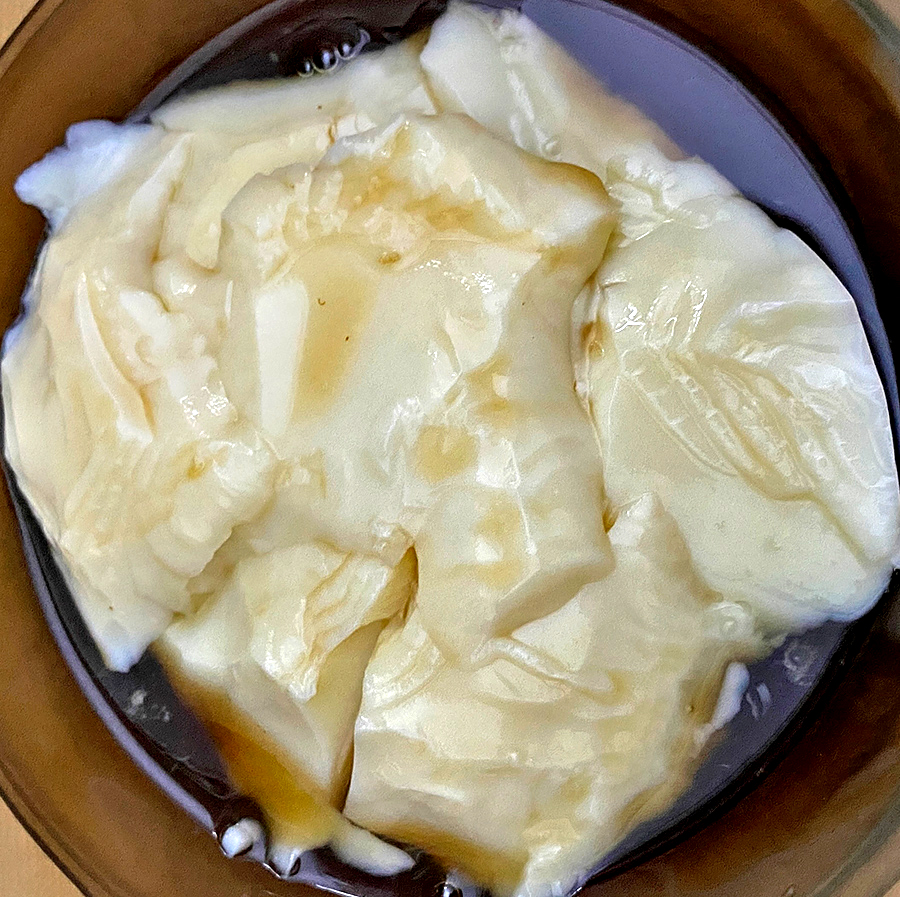|

Taufu fa
with brown sugar-ginger syrup
How to make taufu fah
-
Source soya
bean milk rather than make your own from soya beans.
The locally manufactured milk is best suited for the purpose
as they are likely to be unsweetened and have no additives
which might interfere with the gelling process.
Do note that I have tried at least two different
processed/manufactured soya bean powders without success.
These are apparently ground beans or spray-dried soya milks.
These powders do not result in taufu fah as we know
it.
-
Heat up 1
litre of fresh soya bean milk to boiling.
Heat helps the GDL release organic acid which is what gels
the soya products in the milk.
-
While the
milk is boiling, prepare this:
-
20
mL of water
-
Add 2.5
g of glucono delta lactone (GDL) crystals or powder.
Dissolve the GDL completely.
GDL is commonly found in baking ingredients shops.
-
Add a
heaped teaspoon of any starch.
The starch will add to the structure of the final gel
desired as the starch granules gelatinize (boiled milk
should have a temperature higher than the gelatinization
point of most commonly used starches).
A note: What is labelled "cornstarch" in products one
sees on the shop shelf, is actually wheat starch. The
term "corn" is derived from the old English term for
grains. You can experiment with different starches e.g.
potato; tapioca; arrowroot etc to see what quality of
taufu fa results. The different starches will vary
in the proportion of amylose (straight-chained polymer)
to amylopectin(branched polymer). The latter is the
starch component that gives starch its sticky feel.
-
When the soya
milk has boiled, decant the whole batch from a height into a
quickly stirred GDL mixture. Give the mixture a quick stir
to mix (do not create bubbles).
Let the milk settle and carefully remove bubbles on the
surface with a scoop if you want a smooth looking finish.
Alternatively, if you have a blowtorch, use that to gently
sweep across the surface of the milk. The heat will pop the
bubbles but be careful not to scorch the milk in doing so.
-
Set the
milk aside to cool.
After about 30 minutes, if you are successful, you will see
gelled soya milk = taufu fah.
The consistency arrived at depends on the quantity of soya
products in the milk and the amount of GDL added. The
proportion given above should work generally but you can
tweak the amount of GDL to optimize for your soya milk.
THE KEY IS NOT to be tempted to add too much GDL - use just
enough.
Too much GDL causes the soya compounds to quickly clump to
each other in fine aggregates and an integral matrix is not
formed. Slow setting allows the required gel lattices to
form.
If at first you don't succeed; try and try again.
-
If you want
quick results and do not mind a more solid/crunchy mouth
feel to your taufu fah then instead of GDL, use plain
agar powder (neither flavored or colored).
To 1 litre of unheated soya milk, add 4 g or less (depending
on how soft a taufu fah is desired but remembering
that too little will not result in a gel).
While constantly stirring, bring the milk/agar mix to a
boil.
And then set aside to let the mixture cool.
The taufu fah will form when the setting temperature of
the agar used is reached (usually around 45C). I quite like
this form of taufu fah even though it does have a
different mouth-feel. It is akin to a very, very soft agar
concoction.
|